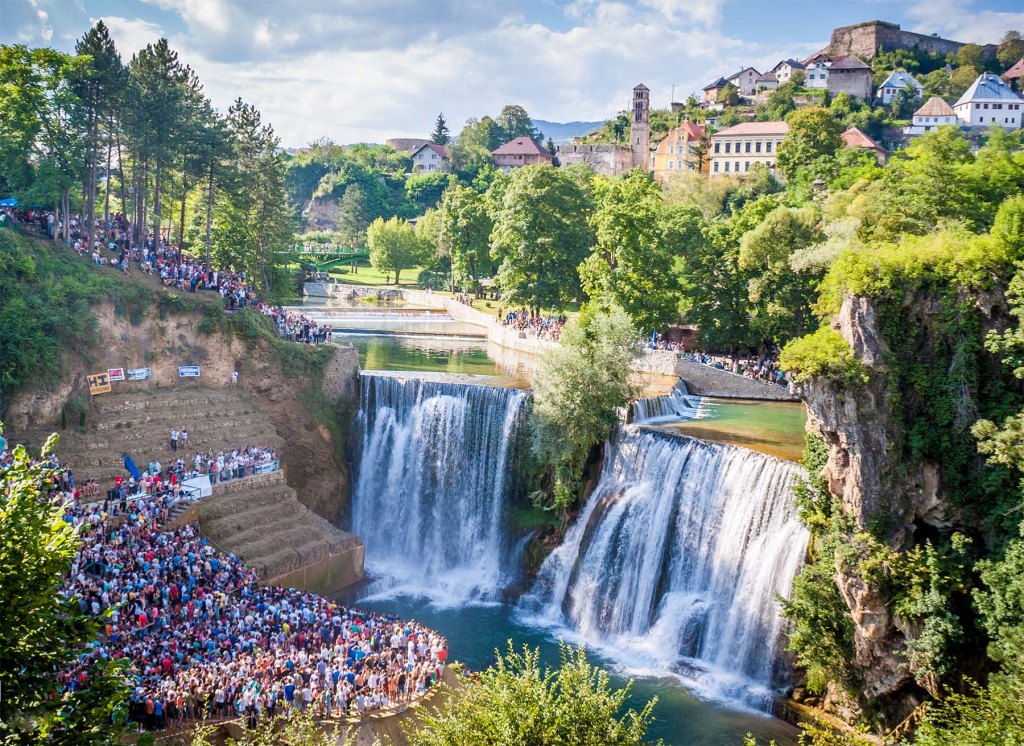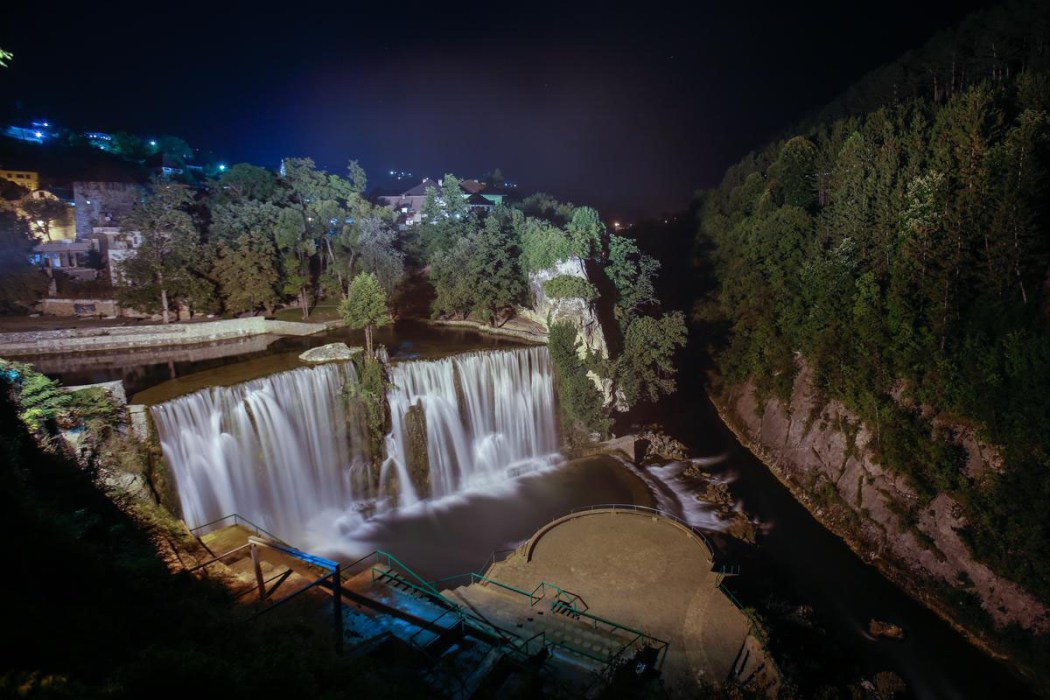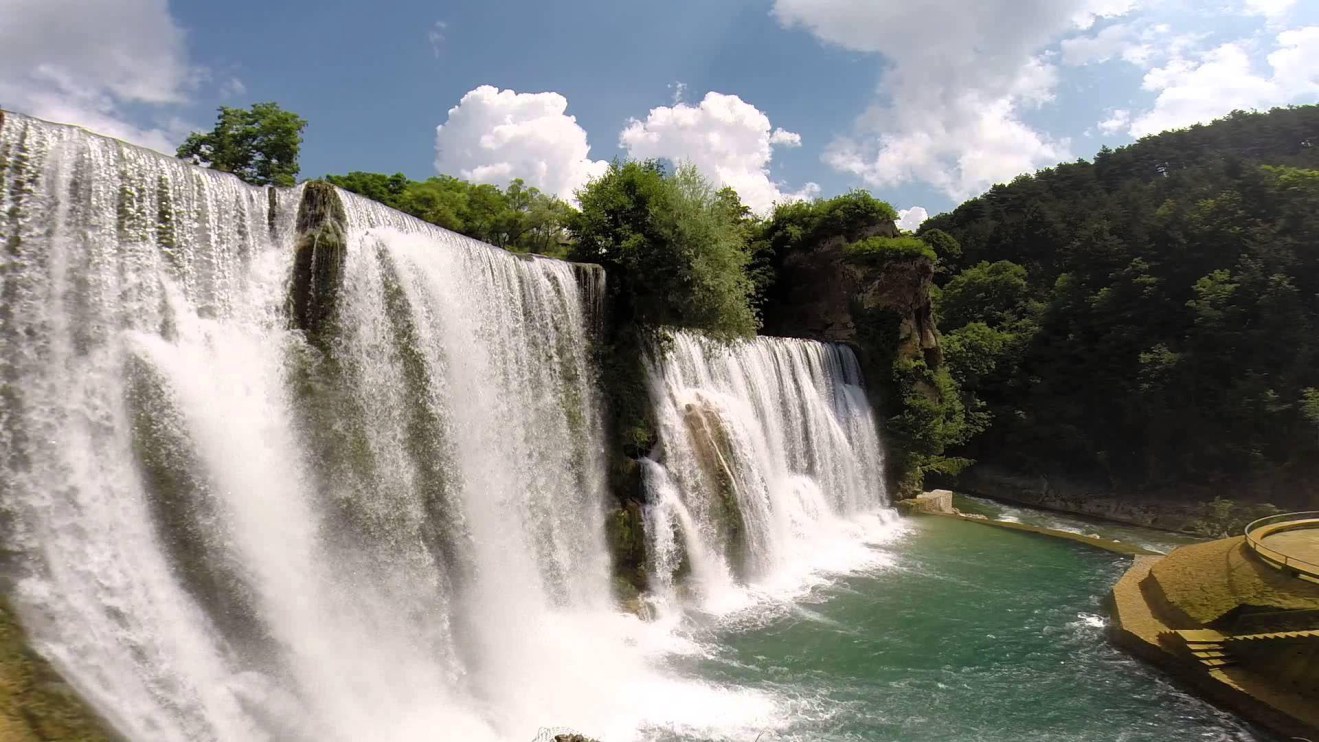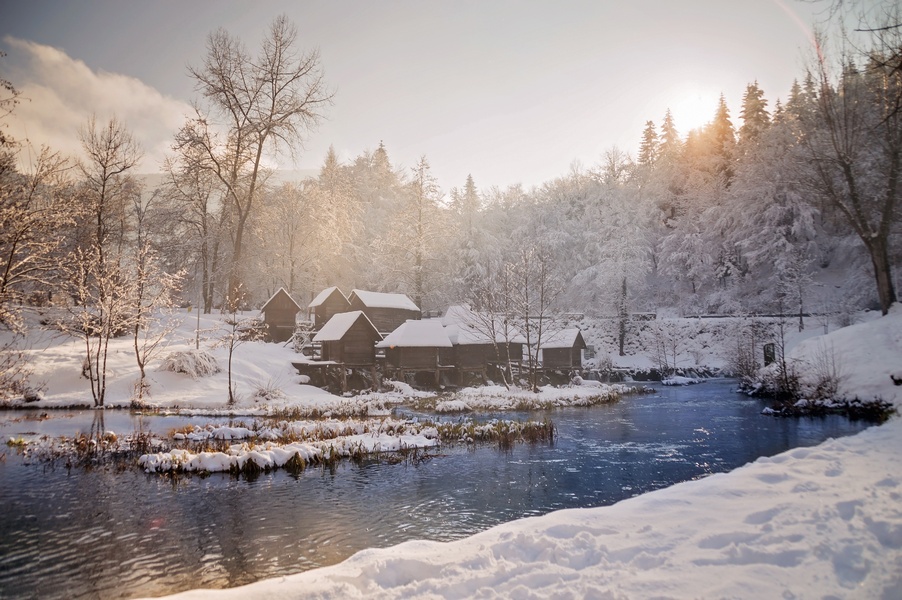
The town of Jajce is located on the banks of rivers Vrbas and Pliva, 164 km north-west of Sarajevo.
Built in the 14th century, Jajce at the time was the capital of the Bosnian Kingdom. The kingdom fell to the Ottomans in 1463, but was retaken the following year by Hungarian King Matthias Corvinus. Eventually in 1527, Jajce became the last Bosnian town to fall to the Ottoman Empire. Bosnia and Herzegovina is rich with waterfalls and most of them have formed on travertine barrages – natural barriers of porous and rather soft limestone which has been deposited by lime-rich water.
Pliva Waterfall is not an exception, on this river have formed many smaller and larger travertine steps but the last one – right at the confluence with Vrbas – is the most impressive. Here the travertine layer is especially thick – up to 70 m and Vrbas River has shaped picturesque, 43 m deep canyon. Waterfall is located just a few metres before the confluence of Pliva with Vrbas, thus opening a fine view on the falls from the opposite side of Vrbas valley.
Pliva Waterfall
It was 30 meters high, but during the Bosnian war, the area was flooded and the waterfall is now 22 meters high. The flooding may have been due to an earthquake and/or attacks on the hydroelectric power plant further up the river. Pliva waterfall now forms a single, impresive plunge. Waterfall is some 50 m wide, with a smaller bush covered island in the middle. The northern side of falls is somewhat lower than the southern.
As the water falls, it hits some ledges of travertine but otherwise this is an impressive, wide screen of water. Below the falls is deep plunge pool and one more several metres high barrage of travertine blocks right at the conflluence with Vrbas River. Waterfalls have their own life cycle. Humans may love them, but nature is unrelenting – it creates them and it “disassembles” them again – sooner or later. Travertine is soft material and strong current or the opposite – dry weather – may create cracks and step by step the soft stone is milled. Due to this most falls on travertine are just weak (but permanent) brooks or springs.
Pliva River though is different – during the spring floods or after heavy autumn rains it turns into a fierce torrent but in summer it may dry up almost completely. Pollution from the city makes the things only worse, it helps to disintegrate the travertine. People in Jajce had two possibilities, to look how the beautiful waterfall is destroyed step by step or to reinforce it. They choose the later.
The images from 1950ies already show that waterfall is reinforced by tall concrete walls. But the current sight of waterfall has been created in the late 1990ies and 21st century.
After the Bosnian war damage to the powerplant upstreams from the falls the waterfall was damaged and its height decreased. Emergency works were made in 1997 but more works followed in 2000ies and 2011. Now the whole width of waterfall is reinforced. The plunge pool below the falls has been made deeper in order to allow jumps from the falls. There is developed also a system of low concrete steps before the falls, thus making the stream more even. Often these concrete steps are erroneously presented as other waterfalls. In order to preserve the falls it is important to maintain the hydropowerplant above the falls in good working order in order to provide steady flow of water over the falls. A new viewing platform (adult 2€/child 1€) has been built opposite the falls’ the base, accessed from stairs that start between the bus station and petrol station. If you don’t want to get sprayed (nor pay), you can look down on the falls from either lip. For the classic tourist-brochure photo, cross the big Vrbas bridge and turn left on the Banja Luka road. Walk 500m, then descend 150m through pinewoods from the roadside lay-by to a great but less-frequented. We can argue whether the waterfall after all these works still can be considered to be a natural monument but one is obvious Pliva Waterfall is beautiful.

Pliva lakes and watermills
Located a few kilometers away from Jajce are the Great and Small Pliva Lakes. These lakes offer many recreational opportunities: fishing, kayaking, canoeing, swimming, playing volleyball, biking and walking. There are also public barbeque facilities along the lakeside for picnics. The “heavy” water of these lakes – meaning a high level of hydrogen, makes them particularly still, which creates a stunning reflection of the mountains surrounding them. Their heavy water also makes the lakes ideal for boating activities and training, and they have been the site of major world and European competitions in kayaking and canoeing.

Watermills on the Pliva lake
The watermills are located on the Pliva River, 5km outside of the Jajce town center. The twenty watermills sit upon a limestone partition that separates the Great and Small Pliva lakes. Dating back to the Middle Ages, these watermills demonstrate the historical architecture style and carpentry techniques of the region. Due to the historical, architectural, and geological value of the Pliva lakes and watermills, both were declared to be “National Monuments of Bosnia and Herzegovina” in 2009.

Getting there
Jajce is approximately 140 kilometres from Sarajevo, 70 kilometres from Banja Luka and 165 kilometres from Mostar. Getting to Jajce can be relatively difficult – the town is no longer served by train, with the line to the town having closed in 1975, and buses to the capital, Sarajevo, unsuitable for a day trip, with the final bus leaving Jajce at 17:30. Therefore, most visitors come to Jajce on an organised tour or with their own car. Jajce’s central bus station lies below the Old Town.
From Sarajevo, the town of Jajce is about a 4 hour bus ride,and costs 37 marks return (19€). You can buy the ticket either at the main bus station or book them in the Centrotrans office in Ferhadija street, Sarajevo. Please note that when buying return you have to reserve the ticket to book yourself a seat on the bus ride back to Sarajevo. I recommend taking the 7.30am bus that goes to Bihać and then just get off at Jajce, which should arrive around 11.30am. The bus back to Sarajevo is at 5.35pm leaving you 6 hours to explore the old town and waterfalls. Bus from from Banja Luka is about 90 minutes ride and costs 5 euro. The shortest travel distance between Jajce (BA) and Mostar (BA) is 164 km. Bus from from Mostar is about 4 hour ride and costs 11 euro one way. From Zagreb the bus takes 5 hours and costs around 18 Euro. The shortest travel distance between Zagreb (HR) and Jajce (BA) is 255 km.
